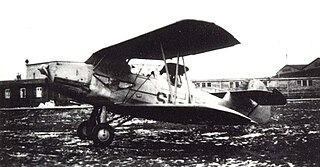
The Arado Ar 66 was a German single-engined, two-seat training biplane, developed in 1933. It was also used for night ground-attack missions on the Eastern Front. It was engineer Walter Rethel's last design in collaboration with Arado, before Walter Blume, assigned as Arado Flugzeugwerke's chief design engineer in 1933, took over the bulk of the Arado firm's design duties.

The Heinkel He 45 was a light bomber produced in Germany in the early 1930s, one of the first aircraft adopted by the newly formed Luftwaffe. Its appearance was that of a conventional biplane and included seating for pilot and gunner in tandem, open cockpits. Developed in parallel with the He 46, it appeared in 1931 as a general-purpose biplane and was employed mainly as a trainer, but was also used by the Luftwaffe for reconnaissance and light bombing duties. Production of this plane totalled 512 aircraft, including those built under licence by Gotha, Focke-Wulf, and BFW.

Friedrichshafen FF.49 was a German, two-seat, single-engine float-plane designed by Flugzeugbau Friedrichshafen in 1917.

The Gotha Go 145 is a German World War II-era biplane of wood and fabric construction used by Luftwaffe training units. Although obsolete by the start of World War II, the Go 145 remained in operational service until the end of the War in Europe as a night harassment bomber.

The Friedrichshafen G.I was a prototype heavy bomber aircraft that was built in Germany by Flugzeugbau Friedrichshafen in 1915. It was Karl Gehlen's first design for the company, and although it was not produced in quantity, it provided the foundation for the later, highly successful bombers culminating in the G.III.
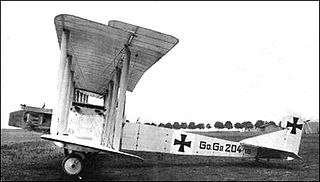
The Gotha G.II series was a heavy bomber used by the Luftstreitkräfte during World War I.

The Friedrichshafen FF.31 was a two-seat prototype German maritime reconnaissance floatplane built by Flugzeugbau Friedrichshafen during the First World War. Although primarily intended for reconnaissance duties, the aircraft was provided with a machine gun to engage other aircraft. Although it was satisfactory for its intended mission, it lacked the performance necessary for use as a fighter. A pair of aircraft were built in 1915 and it was not accepted for production by the Imperial German Navy's Naval Air Service.
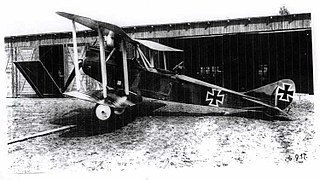
The Rumpler C.IV was a German single-engine, two-seat reconnaissance biplane. It was a development of C.III with different tail surfaces and using a Mercedes D.IVa engine in place of the C.III's Benz Bz.IV. The Rumpler 6B 2 was a single-seat floatplane fighter variant with a 120 kW (160 hp) Mercedes D.III engine built for the Kaiserliche Marine.
The Gotha G.VII. a.k.a.GL.VII, was a bomber aircraft produced in Germany during the final months of World War I. With the strategic bombing campaign effectively over, it was intended to be a high-speed tactical bomber with a secondary reconnaissance capability. It was a conventional two-bay biplane design with tractor-mounted engines, and a conventional empennage with twin fins and rudders. The bombardier's position in the nose of the aircraft that had featured on earlier Gotha designs was removed, and the nose of the aircraft severely truncated and fitted with a streamlined nose-cone. This allowed the engines to be located further inboard than on previous designs, bringing them closer to the aircraft's centreline and therefore minimising the effects of asymmetric thrust in the event of an engine failure. The engine nacelles also featured careful streamlining.

The Gotha LD.1 and its derivatives were a family of military aircraft produced in Germany just before and during the early part of World War I. Used for training and reconnaissance, they were conventional designs with two-bay unstaggered wings, tailskid landing gear, and two open cockpits in tandem. Made quickly obsolete by the rapid advances in aviation technology, several were supplied as military aid to the Ottoman Empire when withdrawn from German service.
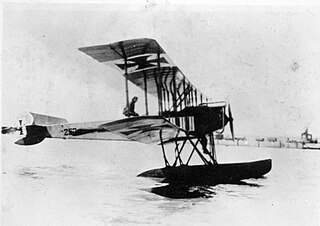
The Gotha WD.2 and its derivatives were a family of military reconnaissance aircraft produced in Germany just before and during the early part of World War I.
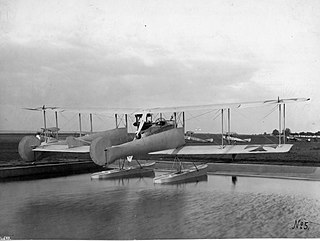
The Gotha WD.3 was a pusher reconnaissance floatplane built in prototype form in Germany in 1915.

The Gotha WD.7 was a reconnaissance floatplane developed in the German Empire during World War I.

The Gotha WD.11 was a torpedo bomber seaplane developed in Germany during World War I. When the general configuration of the Gotha WD.7 proved promising, Gotha set to work designing a much larger and more powerful aircraft along the same general lines. Like its predecessor, it was a conventional biplane with twin engines mounted tractor-fashion on the lower wing. The pilot and observer sat in tandem, open cockpits and the landing gear consisted of twin pontoons. 12 examples were built for the Imperial German Navy.

The Gotha WD.14, WD.20, and WD.22 were a family of biplane torpedo bomber floatplanes developed in Germany during World War I.

The Gotha Go 150 was a light aircraft designed at the German company Gothaer Waggonfabrik in the late 1930s. It was intended for civilian use, but ended up being used as a military trainer.
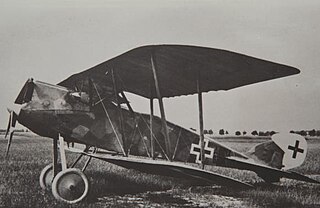
The Aviatik C.IX was a prototype German observation aircraft built by Aviatik in the final months of World War I.
The LVG C.VIII was a prototype reconnaissance aircraft built in Germany during World War I.

The LVG D.VI was a prototype German biplane fighter built by LVG in World War I.
The Märkische D.I was a prototype single-seat fighter biplane built in the last months of World War I.


















